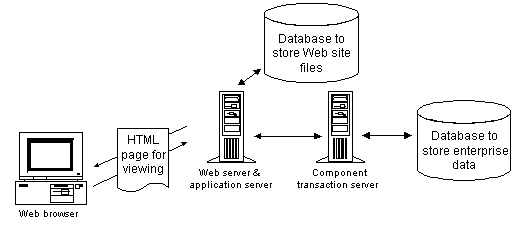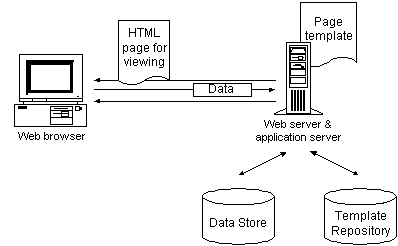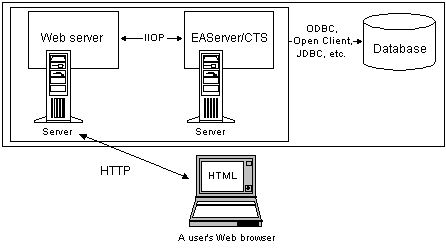In Web delivery environments, application and transaction servers play a vital role in delivering dynamic content to Web site users by extending the capabilities of a Web server and integrating database management systems (DBMS) into the delivery strategy.
An application server processes server scripts to produce customized pages, whereas a transaction server manages components that encapsulate business logic and manage database connections. An application server can integrate with, but does not require, a transaction server.
Web delivery environments use several types of application and transaction servers.
This type of server |
Performs these actions |
|---|---|
Application server as a Web server; personal Web server |
Manages requests for Web pages |
Application server as a dynamic page server |
Processes server-side scripts |
Component transaction server |
Provides access to components that provide business logic |
Database management system |
Provides database access |
These servers can run on one machine, or run on a number of machines for load balancing. The following illustration shows an environment where the Web server and application server run on the same system, and the component transaction server on another system. In this example, the application server uses its own database to store all of the files included in the Web site:
Figure 1-1: Web server environment example

You can use any commercially available Web server that can communicate with the application servers where you deploy a Web target.
Web target type |
Application server |
Web server |
|---|---|---|
Web site target |
Active Server Pages |
Microsoft Internet Information Server (IIS) or a Web server that can communicate with the Active Server Pages application server through ISAPI or CGI |
Other application servers (deploy using the Basic deployment controller) |
Any Web server that can communicate with the application server where you deploy the Web site target |
|
JSP target |
Tomcat |
Apache Tomcat or any Web server that can communicate with the Tomcat application server |
EAServer |
EAServer or any Web server that can communicate with the EAServer application server |
|
Other JSP 1.2 servers (You can use third-party command line tools to deploy a JSP target to other JSP servers.) |
Any Web server that can communicate with the application server where you deploy the JSP target |
These application servers create dynamic pages on the fly by processing server-side scripts. The scripts are part of a template (source) page. A template page can contain HTML and client scripts as well as server scripts.
An application server also acts as an intermediary between a Web server and a DBMS. Page templates can be stored in one database and the data accessed from Web pages in the same or another database. The following figure shows how an application server integrates into a Web delivery environment (without a transaction server):
Figure 1-2: Web delivery environment without transaction server

Transaction servers are used in multitier applications to host executable components. They make it possible to shift processing to the middle tier, enabling application clients (such as Web pages) to be thin. They also handle database connections, thereby distributing the processing load and making it easy to manage connections through connection caching and pooling.
The EAServer component transaction server can host various kinds of components, including Java classes, JavaBeans, Enterprise JavaBeans (EJBs), servlets, JSPs, and PowerBuilder objects. Web targets provide ready access to a server and its components, including Web DataWindow server components.
A key feature of dynamic Web pages is the ability to retrieve and update database information. A Web target’s support for application server technologies makes it easy to incorporate dynamic database content into Web pages.
![]() Using the Web DataWindow
Adding a Web DataWindow to a Web page facilitates retrieving
and updating database information. See the DataWindow
Programmer’s Guide.
Using the Web DataWindow
Adding a Web DataWindow to a Web page facilitates retrieving
and updating database information. See the DataWindow
Programmer’s Guide.
EAServer provides the following services:
HTTP server
Component transaction server (CTS)
JSP server
The basic architecture and communications protocols used by the transaction server and the page and personal servers are shown below:
Figure 1-3: Web delivery environment with transaction server

![]() Can be a single server
The Web server and the component transaction server can be
on the same server machine.
Can be a single server
The Web server and the component transaction server can be
on the same server machine.
4GL Web pages provide enhanced integration with EAServer environments. They make it easy for you to access EAServer components, bind properties of those components to controls on your page, manage page data, and simplify server scripting tasks.
![]() JSP and EAServer only
You cannot use 4GL Web pages if you deploy your Web pages
to an ASP application server, or if you use a transaction server
other than EAServer. A 4GL-enabled
Web page can be used only in a JSP target.
JSP and EAServer only
You cannot use 4GL Web pages if you deploy your Web pages
to an ASP application server, or if you use a transaction server
other than EAServer. A 4GL-enabled
Web page can be used only in a JSP target.
For how to work with 4GL JSP pages, see Chapter 9, “Developing 4GL JSP Pages.”